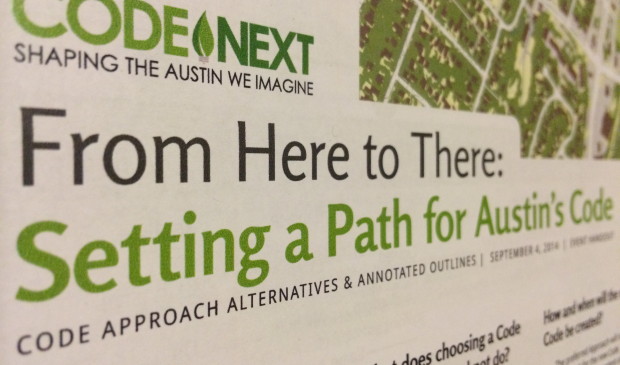Commission backs middle ground approach to LDC rewrite
Monday, September 22, 2014 by
Tyler Whitson Despite disagreement over the best way to move forward with CodeNEXT, the Zoning and Platting Commission has approved city staff’s recommendation for a middle-ground approach to rewriting the Land Development Code.
Commissioner Gabriel Rojas was the only commissioner to vote against the item at Tuesday’s meeting, asserting that Planning and Development Review Department staff’s recommendation was not comprehensive enough.
“I felt that we, as a city, can go a lot further in terms of leading the nation in sustainability,” Rojas told the Austin Monitor. “I felt like a rewrite or a tinkering around the edges wasn’t enough and that we could start from the ground up and actually have a superior code.”
The three approaches that staff presented as options were a “brisk sweep,” a “deep clean” and a “complete makeover.” Rojas said that he would have voted in favor of a complete makeover, rather than the deep clean that staff recommended.
The brisk sweep is a cleanup of code with minor additions and refinements, but no major structural or organizational changes. The complete makeover is closest to a ground-up approach, which staff said provides the “most extensive modifications” to the code.
The deep clean falls somewhere in between. Staff said it “significantly reworks the content and structure” and “substantially improves the appearance, usability and consistency” of the code.
The brisk sweep allows the least implementation of newer zoning standards models throughout the city while the complete makeover allows the most.
The newer models are alternatives to the city’s current zoning standards — known as Euclidean zoning — which are based on desired-use categories such as single-family residential, multifamily residential, commercial and industrial.
Other zoning models include form-based standards, which emphasize the appearance and form of buildings rather than their use, and performance standards, which emphasize the impacts of development on a community and the environment. A fourth model, called hybrid code, combines elements of all three.
Rojas, who said that he considers Euclidean zoning to be “kind of a mistake,” emphasized the need for walkability within the city.
A few commissioners expressed interest in how the different approaches relate to form-based standards.
Planning and Development Review Department Liaison Matt Dugan said that, though the city would most extensively and quickly implement form-based standards with a complete makeover, it could eventually achieve the same goal after a deep clean by “just expanding the number of areas and places that would get a form-based code.”
Commissioner Sean Compton said that he preferred an approach that is “adaptable, but predictable,” because development forms and trends can change over time.
“I would go with the recommended approach, because it has the flexibility of including some form-based code,” Compton said. “Ten years from now, I don’t know if form-based code is going to be around.”
In addition to zoning standards models, staff’s recommendation distinguishes among three development review models that determine the development application process and how code is used. They are by-right, discretionary review and customized zoning.
According to staff, by-right is the clearest and most effective model while discretionary review is less specific and more subjective. Customized zoning, which includes planned unit developments, is the least effective option.
The complete makeover relies primarily on by-right review, while the deep clean relies mostly on a combination of by-right review and customized zoning, with some discretionary review.
Dugan said that, though the deep clean is not as radical as the complete makeover, it could eventually get there. “There would still be a mix,” he said, “but over time, I think the idea would be to shift more and more to a by-right model.”
Though it is still in its relatively early stages, the CodeNEXT process will continue to move forward as part of the Imagine Austin plan until the new code goes into effect in 2017.
Staff is currently presenting the item to a number of boards and commissions. They’re scheduled to go to the Code Advisory Group and Design Commission on Monday, followed by the Planning Commission on Tuesday.
Staff also plans to brief City Council Oct. 2. Council has scheduled a hearing Oct. 23, when it will likely vote on the approach. The new Council will likely vote on whether to confirm that approach in March or April of next year.
You're a community leader
And we’re honored you look to us for serious, in-depth news. You know a strong community needs local and dedicated watchdog reporting. We’re here for you and that won’t change. Now will you take the powerful next step and support our nonprofit news organization?










